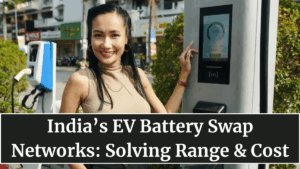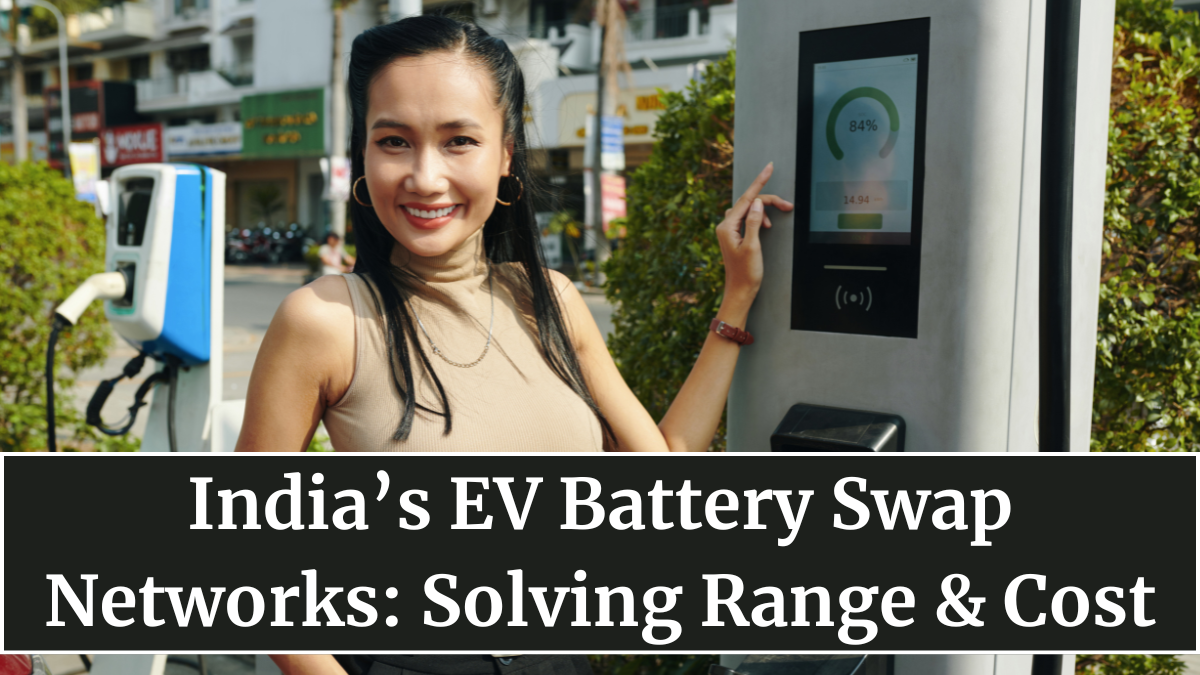India’s EV battery swap networks are becoming one of the biggest breakthroughs in the electric mobility ecosystem. As electric vehicle (EV) sales continue to rise, battery swapping is solving one of the biggest challenges faced by EV users—range anxiety and long charging times. This model lets drivers exchange depleted batteries for fully charged ones at designated EV swap stations in India, reducing downtime and operational costs for both personal and commercial users.

How Battery Swapping Works
Battery swapping allows an EV owner to replace a discharged battery with a fully charged one at a swap station in just a few minutes. Unlike traditional charging stations that require up to an hour or more for a full charge, swapping takes less than five minutes. The technology works best for two-wheelers, three-wheelers, and fleet vehicles, where time efficiency and high utilization are critical.
Companies such as SUN Mobility, Gogoro, Ola Electric, and Bounce Infinity are pioneering this model by installing thousands of smart swapping stations across urban centers and highways. These stations use automated lockers, IoT-enabled tracking, and subscription-based plans for users, making EV ownership more flexible and affordable.
Policy Push and Government Support
The Indian government’s Battery Swapping Policy, proposed under the FAME-II scheme, aims to standardize battery sizes, connectors, and charging protocols. This ensures interoperability between vehicles and swapping networks, allowing users to access any compatible swap station across the country.
States such as Delhi, Maharashtra, and Tamil Nadu have already included swapping incentives in their EV policies to attract private players and startups. This support not only encourages adoption but also boosts local manufacturing of swappable batteries under the ‘Make in India’ initiative.
Economic and Environmental Impact
Battery swapping helps reduce the upfront cost of EVs because batteries account for nearly 40% of the total vehicle cost. By decoupling battery ownership, customers can purchase vehicles at a lower price and pay only for energy usage through monthly plans.
Moreover, optimized battery use extends battery life and promotes recycling and circular economy practices, reducing environmental waste. Fleet operators such as e-rickshaw companies and last-mile delivery platforms benefit significantly from predictable running costs and zero downtime.
Challenges Ahead
Despite the progress, challenges remain in achieving large-scale interoperability. Currently, each manufacturer tends to design its own battery format, making universal swapping difficult. There’s also the question of battery ownership models, warranty responsibility, and safety compliance.
Additionally, rural and semi-urban regions still lack sufficient swap infrastructure due to high setup costs and lower EV density. Addressing these issues will require coordinated efforts between automakers, energy providers, and policymakers.
The Road Ahead for India’s EV Ecosystem
The next few years will be crucial for scaling battery swapping in India. As infrastructure expands and standards evolve, users will experience faster, cheaper, and more convenient electric mobility. With the rise of connected swap stations and digital payment integrations, India is positioning itself as a leader in affordable EV solutions for the developing world.
Battery swapping might not replace fixed charging completely, but together they can create a hybrid ecosystem where both urban and rural mobility needs are met efficiently. For India’s growing EV market, this represents not just technological innovation but also a strategic step toward energy independence and sustainability.
FAQs
What is an EV battery swapping station?
An EV battery swapping station allows users to replace their depleted batteries with fully charged ones instantly, instead of waiting for traditional charging.
How is battery swapping different from charging?
Swapping saves time by exchanging batteries in minutes, while charging requires plugging in and waiting until the battery is recharged.
Which companies are leading India’s battery swap market?
Major players include SUN Mobility, Ola Electric, Bounce Infinity, Gogoro, and Battery Smart, among others.
Is battery swapping available for four-wheelers in India?
Currently, it is mostly implemented for two- and three-wheelers, but trials for four-wheelers and fleet taxis are under development.
What are the benefits of battery swapping?
Key benefits include faster turnaround time, lower vehicle cost, flexible ownership, and reduced range anxiety for EV owners.
Click here to know more.
